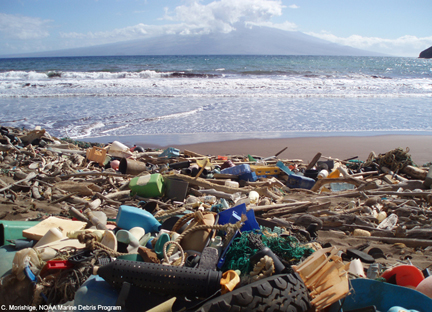
A man looks at a 70-foot-long dock with Japanese lettering that washed ashore in Newport Oregon more than a year after a tsunami devastated Japan (Photo: AP Photo/Rick Bowmer, File)
About a year after the Japanese earthquake and tsunami, debris from the disaster drifted across the Pacific Ocean, washing up on beaches in the western United States and Canada.
At first, it consisted mostly of small and lightweight materials like pieces of Styrofoam or soccer balls. After a while, the wayward debris began to get larger in size.
A hefty shipping container holding a Harley-Davidson motorcycle showed up on a Canadian beach while a 20-meter-long dock made its way to Oregon shores.
The arrival of the tsunami debris highlights the global problem of marine debris. The US National Oceanic and Atmospheric Administration’s (NOAA) Marine Debris program addresses this growing concern. The program supports global efforts to research, prevent and reduce the impacts of marine debris.

An example of marine debris that washed up on a shore (Photo: NOAA Marine Debris Program)
Nancy Wallace, program director and division chief of NOAA’s Marine Debris Program defines marine debris as any solid material that ends up in the marine environment of oceans, lakes and other waterways that shouldn’t be there.
Wallace says marine debris is a serious issue which can impact everything from wildlife and habitat to boater safety. It can also cause economic problems.
For some time now, there have been reports of growing islands of trash and garbage floating around in the ocean. Wallace says NOAA gets questions about this all of the time.
“It’s a good thing to clarify,” she says. “There is no floating island of trash out in the ocean. There are areas where the currents come together and that’s areas where debris can end up, sort of accumulating, but there is not a big land mass of trash out there.”
One of the more infamous accumulations of marine debris is the Great Pacific Garbage Patch, also known as the Eastern Garbage Patch. This intense concentration of marine debris is located between Hawaii and California.

A seabird dies after getting trapped in marine debris such as these old fishing nets (Photo: Ocean Conservancy)
Wallace describes the debris patches as, “a piece here, a piece a few yards or even miles away and a lot of it’s very, very tiny. A lot of it’s plastics that have broken up in very small pieces.”
Marine debris can do great harm to wildlife. According to Wallace, when fish or birds eat it, the debris can get lodged in their digestive systems, causing a variety of problems. Whales, marine mammals and sea turtles become entangled in debris such as fishing nets and other fishing gear. Coral reefs and other crucial and sensitive habitats can also be harmed by wayward trash, which in turn could harm the marine life that depends on them to order to survive.
Marine trash causes problems for boaters when pieces of it get stuck in the boat’s propeller blades.

Volunteers gather to clean up marine debris that washed up on shore (Photo: Ocean Conservancy)
Wallace also cites the economic impact of marine debris saying that people are often saddled with the costs of having to clean up the trash that washes up onto beaches and shorelines. Tourism, an industry many areas depend upon for income, can drop if too much trash accumulates along the beaches.
Marine debris, Wallace says, is for the most part, preventable. Much of it, she says, comes from people littering, not recycling or not being careful with what they do with their trash.
NOAA’s Marine Debris program, which is trying to raise awareness about the problem, emphasizes that every person can have an impact.
Nancy Wallace talks more about what NOAA is doing to address the problem of marine debris on this week’s radio edition of “Science World.” Check out the right column for scheduled air-times or listen to the interview with Ms. Wallace below.
Audio clip: Adobe Flash Player (version 9 or above) is required to play this audio clip. Download the latest version here. You also need to have JavaScript enabled in your browser.
Other stories we cover on the “Science World” radio program this week include:
- 19th International AIDS Conference takes place in Washington, DC
- Greenland ice melts at unusually fast rate this month
- U.S. droughts linked to climate change
- Asian health workers scramble to contain outbreak of hand, foot and mouth disease
- Space pioneer Sally Ride dies of cancer at 61
- US engineers work to keep Mississippi River navigable as drought decreases its depth

 Science World is VOA’s on-air and online magazine covering science, health, technology and the environment.
Science World is VOA’s on-air and online magazine covering science, health, technology and the environment.